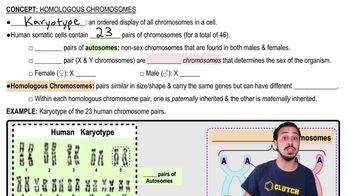DRAW IT The diagram shows a cell in meiosis.
c. Identify the stage of meiosis shown.




DRAW IT The diagram shows a cell in meiosis.
c. Identify the stage of meiosis shown.
Assume that genes A and B are on the same chromosome and are 50 map units apart. An animal heterozygous at both loci is crossed with one that is homozygous recessive at both loci. What percentage of the offspring will show recombinant phenotypes resulting from crossovers? Without knowing these genes are on the same chromosome, how would you interpret the results of this cross?
Two genes of a flower, one controlling blue (B) versus white (b) petals and the other controlling round (R) versus oval (r) stamens, are linked and are 10 map units apart. You cross a homozygous blue oval plant with a homozygous white round plant. The resulting F1 progeny are crossed with homozygous white oval plants, and 1,000 offspring plants are obtained. How many plants of each of the four phenotypes do you expect?